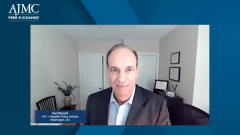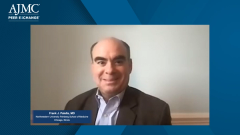
USPSTF Guidelines for HIV PrEP: Using Medical Management Techniques
Sean E. Bland, JD, provides insight for when a health plan or issuer may use reasonable medical-management techniques, in accordance with USPSTF guidelines for HIV PrEP, and Ryan Bitton, PharmD, MBA, shares a payer perspective on utilization-management policies regarding PrEP.
Episodes in this series

Ryan Haumschild, PharmD, MS, MBA: Another question that comes up is when might a planner or issuer use reasonable medical-management techniques? That’s some jargon that needs to be peeled back. I’m going to turn to our resident expert, Sean. We’re looking at this guidance, and when you hear that, what does that mean for our health plans? What was the intended guidance by that statement?
Sean E. Bland, JD:The main thing about management techniques is that these could encourage patients to use certain services or medications over others. Plans and insurers may use medical-management techniques when the guidance does not specify the frequency, the method, the treatment, or the setting of surface provision. What this means for the provision of PrEP [pre-exposure prophylaxis] medication is that reasonable medical management is permitted to give preference to specific medications, such as ones without cost sharing and imposing cost sharing for other products. For example, plans may cover a generic version of PrEP without cost sharing and apply cost sharing to an equivalent branded version. However, plans are required to accommodate any individual for whom a particular PrEP medication—generic or branded—would be medically inappropriate. That’s medically inappropriate as determined by the individual’s health care provider. This requires that plans have a mechanism for waiving otherwise applicable cost sharing. If plans use these types of techniques to limit access to specific PrEP products or services, they must also have an exceptions process that is easily accessible, that’s transparent and also sufficiently expedient. Also, this process can’t be unduly burdensome on individuals or on their providers. Hopefully, that gives some context of what’s meant by medical-management techniques and what it needs to be. It needs to be a reasonable approach that allows for access to happen.
Ryan Haumschild, PharmD, MS, MBA: It’s interesting because transparency, making it easily accessible, having a good exceptions process—sometimes when you unpackage our payer policies, it can be a little trickier in the eye of the beholder. The way they execute is important. Ryan, what are the utilization-management policies that you have regarding PrEP? Do they meet those requirements? Have you heard any feedback? Is that a work in progress? Especially when we talk about an expedited process, transparency, and easy.
Ryan Bitton, PharmD, MBA: Good question. Each of those words—expedited, transparent, easy—has lots of definitions. To your point, what might be easy for me living in the payer space for 15 years may not be easy for other folks. In my organization, in many organizations, there’s a preference for certain medications that are less expensive. There are referencing strategies around that medication. I’ve worked with local providers in my community to share a transparent format. Here are the criteria we’re using. You don’t need to guess when this patient is an exception and they need the more expensive product, and they need to go through that process. There was always some confusion. We need to be transparent and say, “Here’s the policy,” put those policies out and post them. It’s not a guessing game when you’re submitting for that exception. It’s important. It helps to be transparent.
Outreach that I have with 1 provider in my community was helpful. He was getting frustrated. There’s a lot of frustration out there because there’s not a lot of consistency. Even if we have consistent policies, you’ve got different numbers to call, different forms to use. There’s some complexity. Unfortunately, that’s the health care system, and we have to deal with it. Once people are aware of the process, it is easy and it can be transparent. As far as expedited goes, is that 24 hours or 72? It depends on the line of business, but for a lot of payer policies, once you say expedited, it’s 72 hours or less. In the world of Medicaid, we’re talking 24 hours. For a lot of folks, it’s easier to say, “This is 1 of those expedited things we’re going to throw it in the bucket to get it done as fast as you can.” We’re probably we’re going to get it done faster than 72 hours. A lot of organizations are similar. We have 24-hour processes, so let’s throw these things into those 24-hour processes.
Ryan Haumschild, PharmD, MS, MBA: I appreciate you giving us a little background on those terms because they can be interpreted differently. One that comes up all the time is medical necessity. We deal with it across so many therapeutic areas. It’s nothing new, but when we think about these FAQs [frequently asked questions], how do you all and the payers accommodate for medical necessity? Do you utilize prior authorizations to meet that requirement? Is there a denial or appeal process? In this process of PrEP for some of these therapies, what are some of those criteria that you utilize to classify something as a medical necessity? What is that pathway to work through a medical necessity appeal or prior authorization?
Ryan Bitton, PharmD, MBA: There’s a lot there. Allow me to package this. With the members and providers, there’s always an exceptions process or an appeals process. That’s always there. It may be time consuming and complicated, but there’s a process. There’s always a way to do that. What does medical necessity mean? It’s tough to define. It’s probably easy to define, but there are different definitions. My interpretation is that there are probably 2 levels. One, medically necessary means we have supported data, FDA indication, guideline recommendations. There must be medical support for the use of the product in general. We as payers sometimes prefer product A vs product B. But there are moments when product A is not appropriate. In those cases, it becomes medically necessary for the patient to use product B. Most colleagues in managed care can identify specific examples of exceptions when product B needs to be used. We write those into our criteria, and we approve the $0 co-pay in those situations. Of course, there are situations that can’t fall into a medical policy. That’s where each individual review through the exceptions process will also determine medical necessity.
Ryan Haumschild, PharmD, MS, MBA: You used some of the terminology as time consuming and complex. I remember speaking with a payer 1 time who said, “It’s time well spent.” It’s interesting to see the different perspectives from a provider and payer as we work through these medical necessities, because you may see it as an appropriate step to manage the benefit. The provider may feel as if it’s time wasted that could have been spent on patients. It’s interesting to see the different approaches.
Transcript Edited for Clarity
Newsletter
Stay ahead of policy, cost, and value—subscribe to AJMC for expert insights at the intersection of clinical care and health economics.






























































